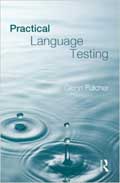May 2015 – Volume 19, Number 1
Practical Language Testing |
|||
| Author: | Glenn Fulcher (2010) |  |
|
| Publisher: | Hodder Education | ||
| Pages | ISBN-13 | Price | |
|---|---|---|---|
| 352 pages | 9780340984482 0340984481 | $44.95 USD | |
Glenn Fulcher’s Practical Language Testing is a rich, practical resource for language educators about assessment. Not only does examine issues of test design and selection, providing teachers information on how to select the appropriate test for a specific instructional context, but also direction for making meaning of the scores such assessments generate. The author urges teachers to think wisely of test context in order to provide students with the most appropriate language testing. While presenting pertinent research-based arguments, Practical Language Testing strikes an effective balance between theoretical foundations and practical applications to help professionals understand the purpose of meaningful assessment and its role in effective teaching and learning.
Highly accessible and organized for its teacher-audience, this practical guidebook potentially serves multiple and overlapping audiences of professional language test designers, administrators, scorers, and/or teachers. In ten chapters, Practical Language Testing outlines the testing process–from early stages of designing an assessment to final steps of delivering the score to the test taker. The guide includes discussions of reliability, dependability, and scorability—key features of high quality tests. Specific and broad concepts are illustrated with relevant research, diagrams, charts, pictures, and vivid examples to support the reader’s understanding. Each chapter ends with an activity section that allows readers to apply the new knowledge gained from the readings. A very strong feature of this book is the glossary that defines basic language testing jargon.
In Chapter 1, Fulcher broadly presents the current contexts of educational testing, discussing its purposes, practices, and implications including controversies surrounding externally mandated tests and the negative washback that often occurs. In Chapter 2, Fulcher briefly outlines how norm-referenced testing works and its theoretical underpinnings. Chapter 3 discusses two prime approaches of classroom assessment: assessment for learning and dynamic assessment. In Chapter 4, the author focuses on the recursive nature of test design. Chapter 5 continues that discussion with an emphasis on item/test specifications (input material), evidence specification (expectations and scores measurements), test assembly specification (number and range of item types), presentation specification (test format), and delivery specification (administration, security, timing).
Chapter 6 provides, among other things, guidelines for designing multiple-choice items. In addition, the chapter discusses the item shell concept (an electronic template for writing test items) and some examples of templates for generating large-scale testing. Chapter 7 deals with scoring language tests. It analyzes the problems associated with measurement components such as the meaning of a score and the extended time spent in scoring. Fulcher introduces scorability as a key feature affecting the quality of a test and gives many examples of early and current methods used in scoring close-response, paper- or computer-based tests.
Chapter 8 discusses the complexity that arises from implementing standards and standards-based testing and the problems associated with that same complexity; and, in in Chapter 9 the author calls attention to high-stakes test administration. According to Fulcher, in order to get a test properly administered, teamwork is required to ensure test security of score meaning, test authenticity, and accuracy of test results. He adds that a good test administration also requires fairness in providing all test takers equal opportunities to perform under standardized conditions. Part of the chapter is specified to controlling extraneous variables that might impact tests’ instructions, performance or scoring (e.g. air conditioning breakdown). The last part of this chapter focuses on the process of language test administering in terms of scoring, data collecting, and outcomes reporting. In his final chapter, Fulcher draws attention the washback hypothesis and the ineffectiveness of teaching to the test.
In conclusion, Practical Language Testing is a considerable resource for professionals in deciding how to choose the most appropriate assessments. By primarily concentrating on the effective design and administration of assessments, the author helps educators develop high quality tests and testing environments compatible to their instruction and standards. He also provides educators with insights into improving students’ testing performances by taking into account all accommodations that are necessary to protect test validity and authenticity.
As language teachers, we were excited to access this text Assessments matter tremendously; and through meaningful, well-designed tests, teachers gain a greater understanding of students’ learning outcomes and can adapt instruction accordingly. As early career Saudi teachers of English, we found the book to be particularly relevant for our own professional development. While our pre-service and in-service professional development has been robust and multi dimensional, neither in our studies in Saudi Arabia nor in the U.S. has assessment been central to our preparation as teachers. We argue that it should be.
Reviewed by
Faizah Alzahrani
University of North Carolina Charlotte
<ialjugha![]() uncc.edu>
uncc.edu>
Iman Aljughaiman
University of North Carolina Charlotte
<falzahra![]() uncc.edu>
uncc.edu>
Jumanah Aljughayman
University of North Carolina Charlotte
<jaljugha![]() uncc.edu>
uncc.edu>
| © Copyright rests with authors. Please cite TESL-EJ appropriately.
Editor’s Note: The HTML version contains no page numbers. Please use the PDF version of this article for citations. |

